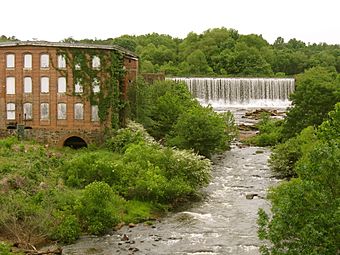Conestee Mill facts for kids
Quick facts for kids |
|
|
Conestee Mill
|
|

Conestee Mill, 2014
|
|
| Location | 1 Spanco Dr., Conestee, Greenville County, South Carolina |
|---|---|
| Area | 140 acres |
| NRHP reference No. | 09000913 |
| Added to NRHP | March 2, 2014 |
The Conestee Mill is a very old and important mill located in Conestee, a small community in Greenville County, South Carolina. It has a long history, from being a Native American campsite to a busy factory, and now it's a beautiful nature park.
Contents
A Look Back: Early Days
Native American History
Long ago, even before European settlers arrived, the Cherokee people often used the area around Conestee Mill as a place to set up camp. They lived and traveled along the Reedy River.
First Mills and Factories
In 1794, a large piece of land, about 200 acres, was bought by Andrew Nelson. This land was on both sides of the Reedy River and included the spot where Conestee Mill now stands. As early as the 1790s, there were already mills here. These were likely "grist mills" (which grind grain into flour) and "saw mills" (which cut wood).
Around 1800, Adam Carruth and Lemuel Alston bought land nearby. Carruth even made muskets (old-fashioned guns) for the states of South Carolina and Georgia. However, his factory didn't last very long.
Growing the Community
McBee Factory Era
By 1820, a small town had started to grow around these early mills. Later, around 1833, a man named Vardry McBee bought the mill buildings and machines. He was known as the "Father of Greenville" because he helped the city grow so much.
Under McBee, the place was called "McBee Factory." It had mills that made paper, wool, and cotton cloth. About 50 people worked there, and the community around the mills had about 150 people.
New Names and a Bigger Lake
After 1875, the mill was known as the Reedy River Factory. Then, in 1909, it was officially renamed Conestee Mills. The main mill building you see today was built in the 1890s. Around 1892, the stone dam was made taller, creating a lake that was about 130 acres (53 ha) big.
Challenges and Comebacks
The Pollution Problem
In the 1900s, the City of Greenville and many other mills upstream started releasing their waste into the Reedy River. This waste flowed into Conestee Lake. The lake became very polluted, causing bad smells and making it hard for anything to live there. The only thing the lake was good for was making power for the mill.
Fighting for Clean Water
In 1925, Conestee Mills took the City of Greenville to court because of the pollution. Even though the mill eventually closed down due to this long legal fight and the Great Depression (a time when many businesses struggled), a court decision in 1931 was very important. It was one of the first big steps in the effort to clean up South Carolina's rivers.
The mill closed in 1939. It reopened in 1946 under new owners but closed for good in 1971. After that, the buildings were used for storage.
A New Beginning: Nature Park
Over many years, the pollution filled about 90 percent of the lake with dirty mud. This mud was so toxic that the lake was called a Superfund site, meaning it needed a lot of cleanup.
In 2000, a group called the Conestee Foundation was created. This group wanted to bring the lake back to life as a natural wetland and create a nature park. They used money from a settlement after a pipeline spill in 1996 to buy the lake and the dam.
After studying the area, experts decided it was safe to leave the toxic mud and dam in place. Today, the Conestee Mill, its dam, and the lake are part of a beautiful nature park and wildlife sanctuary.
Historic Recognition
On March 2, 2014, the Conestee Mill, along with its dam and the lake, was added to the National Register of Historic Places. This means it's recognized as an important historical site.



